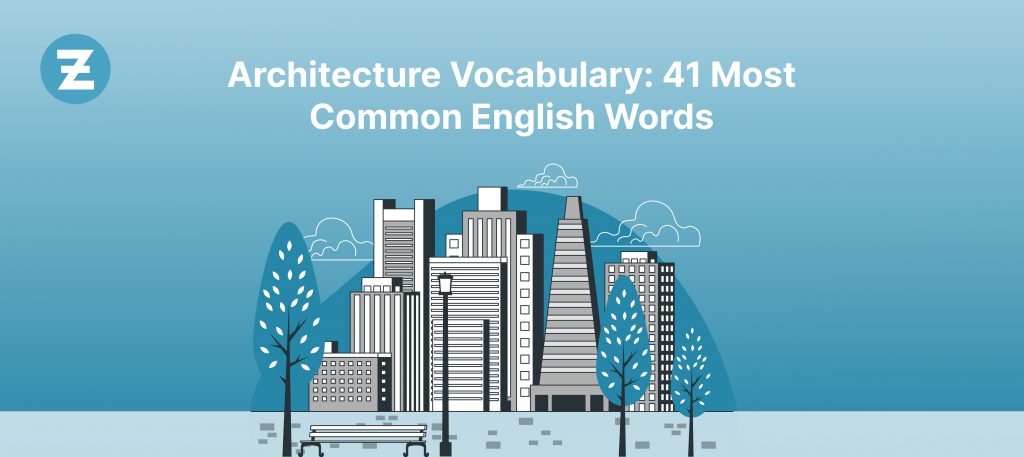Architecture is a fascinating field that combines art, science, and functionality in the design of buildings and structures.
Whether you’re an aspiring architect or simply interested in architecture, understanding the vocabulary used in this field is crucial.
In this beginner’s guide, we will explore some of the essential architecture vocabulary in English.
So, let’s dive in and explore the world of architectural terminology!
| Upgrade your English pronunciation and listening abilities with Zoundslike’s interactive learning platform! |
41 Architecture Vocabulary Words
-
Architect:
A professional who designs buildings and oversees their construction.
-
Building:
A structure constructed to serve a specific purpose, such as a house, office, or school.
-
Structure:
The arrangement and organization of the elements that make up a building.
-
Facade:
The front or face of a building visible from the outside.
-
Foundation:
The base upon which a building is constructed, usually concrete or stone.
-
Roof:
The top cover of a building that protects it from weather elements.
-
Wall:
A vertical barrier that encloses and divides spaces within a building.
-
Window:
An opening on a wall with glass to allow light and air to enter.
-
Door:
An entryway in a wall allows access to a building or a room.
-
Floor:
The level surface of a building where people walk, or objects are placed.
-
Ceiling:
The upper interior surface of a room that covers the roof.
-
Column:
A vertical, load-bearing pillar that supports a building’s structure.
-
Beam:
A horizontal structural element that carries loads from walls or columns.
-
Arch:
A curved structural element that spans an opening and carries loads above it.
-
Dome:
A rounded vault forming the roof of a building or structure.
-
Stairs/Staircase:
A series of steps providing access to different building levels.
-
Balcony:
A platform projecting from a building, enclosed by a railing or balustrade.
Read Also: 25 Australian Slang Words & Phrases You Should Know
-
Façade:
The exterior face of a building, often ornamental and decorative.
-
Floor plan:
A diagram that shows the layout of a building from a top-down perspective.
-
Blueprint:
A detailed technical drawing of a building, often used in construction.
-
Elevation:
A drawing showing the vertical view of one side of a building.
-
Skyscraper:
An exceptionally tall building with multiple floors.
-
Urban planning:
The design and organization of cities and urban areas.
-
Landscaping:
The design and arrangement of outdoor spaces around a building.
-
Sustainability:
Designing buildings with a focus on environmental impact and resource efficiency.
-
Renovation:
The process of restoring or updating a building to its original or improved state.
-
Restoration:
The process of bringing a building back to its original condition.
-
Blueprint:
A detailed plan or design, typically a technical drawing used in construction.
-
Green building:
A construction that is environmentally friendly and energy-efficient.
-
Materials:
The substances used in construction, such as wood, concrete, steel, etc.
-
Atrium:
A central, open space within a building, often with a glass roof.
-
Mezzanine:
An intermediate floor between main levels, often partial or used for specific purposes.
-
Portico:
A covered entrance with columns, typically leading to the main entrance of a building.
-
Facade:
The exterior face of a building, including the walls, windows, and architectural features.
| Improve your listening and speaking skills in English with Zoundslike’s fun and easy-to-use app! |
-
Cornice:
A decorative molding that crowns the top of a building or separates different levels.
-
Pilaster:
A rectangular column-like projection from a wall, often decorative.
-
Balustrade:
A row of small columns topped by a rail, used as a decorative railing on a balcony or staircase.
-
Gable:
The triangular portion of a wall between the edges of a sloping roof.
-
Cupola:
A small, dome-like structure on the roof of a building, often providing light or ventilation.
-
Frieze:
A decorative band running horizontally below the cornice on the exterior or interior of a building.
-
Parapet:
A low protective wall along the edge of a roof, terrace, or balcony.
-
Skylight:
A window set into a roof or ceiling allows natural light into a space.
-
Soffit:
The underside surface of an architectural element, like an arch or a cornice.
-
Mullion:
A vertical element that divides window or door openings into smaller sections.
-
Transom:
A horizontal beam or bar that separates the upper part of a window or door from the lower part.
-
Cantilever:
A structural element that extends horizontally and is supported at only one end.
-
Corbel:
A bracket or projection jutting out from a wall to support a structure above it.
-
Eaves:
The lower part of a roof that overhangs the walls of a building.
-
Pediment:
A triangular gable, often decorated, above the horizontal entablature of a classical façade.
-
Mansard roof:
A roof with two slopes on all four sides, creating additional living space on the upper level.
-
Pergola:
An outdoor structure with an open roof, often covered with climbing plants.
-
Veranda:
A roofed platform outside a building, often with a railing.
-
Oculus:
A circular window or opening, often seen in domes or walls.
-
Lanai:
A covered porch or veranda, especially in Hawaiian architecture.
-
Mullion:
A vertical member that separates individual lights in a window.
Read Also: Speak Like a Brit: The Top 21 Expressions to Learn
-
Final:
An ornament at the top of a pinnacle, roof, or spire for decorative purposes.
-
Oriel window:
A bay window projecting from an upper floor, supported by brackets or corbels.
-
Crenellation:
Alternating high and low sections along the parapet’s top gives a battlement-like appearance.
-
Architrave:
The lower part of an entablature, resting immediately on top of a column.
-
Silhouette:
The outline or general shape of a building or structure.
Conclusion
This beginner’s guide has provided a comprehensive overview of essential architecture vocabulary in English.
By familiarizing themselves with these terms, aspiring architects and enthusiasts can enhance their understanding of architectural principles and effectively communicate their ideas.
This guide is a valuable resource for anyone looking to delve into the world of architecture, whether they are discussing different architectural styles, the elements of a building, or the various materials used in construction.
With this newfound knowledge, individuals can confidently navigate architectural discussions, appreciate the beauty of architectural design, and embark on their architectural endeavors.
For those eager to expand their vocabulary, we recommend the Zoundslike – language learning app. This innovative language-learning platform offers a unique approach to improving English skills, enabling users to communicate effectively in no time.








